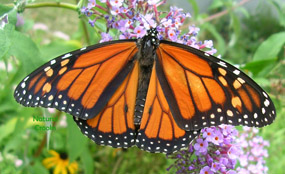Toronto is burning bright with tigery Monarch butterflies. But while it’s fairly easy to tell William from Kate, can you pick the future Monarch kings from among the queens?
A dark spot, smaller than a rice-grain, dots each lower wing near the tail end of the male. These dots are specialized scent scales. The king Monarchs may use captivating fragrances, called pheromones, to lure a wary Queen closer. Females also have thicker black wing lines and differently shaped abdomens.
Paparazzi can even detect the future ruler’s gender while it’s still in its “turquoise house with golden nails” or chrysalis. A tiny vertical indent near the top of the chrysalis means a female is maturing within. No line means it’s a male. (For photos see www.mymonarchguide.com/2008/09/is-it-possible-to-gender-id-pupa.html or http://bugguide.net/node/view/147222.)
Gliding, veering, staggering, and soaring through the air, Monarchs with their 7-10 cm wings appear huge, but they are milkweed-puff light. One Queen-embossed penny weighs the same as 3 to 8 Monarchs.
To encourage more royalty to visit, plant butterfly bush (Buddleia davidii), Echinacea, black-eyed susans and asters. If growing wild milkweed plants to host the caterpillars, please control the spread of these plants by removing seed pods and containing roots.
Adult Monarchs migrate south from Eastern Canada to overwinter in Mexico. In spring, the adults drift regally north, laying eggs. Their offspring continue traveling north, until eventually Monarchs reach Canada again.
Large numbers of Monarchs often gather in parks near the edges of Lake Ontario and Lake Erie in late August and September before their stately crossing. If you’re one of their loyal admirers, you can now decide whether it’s ladies first, or whether the queens are escorted across the choppy waters.

